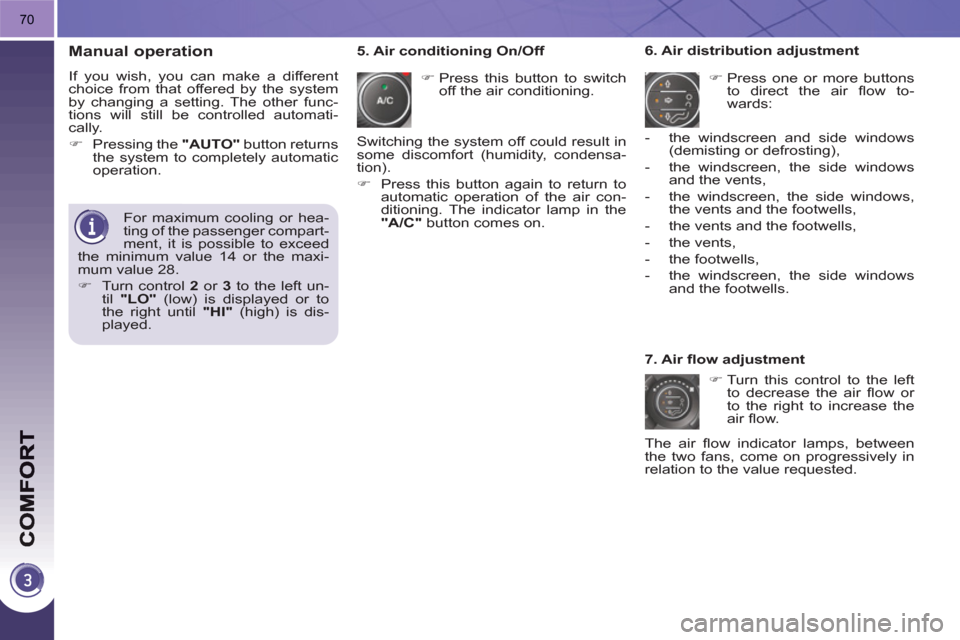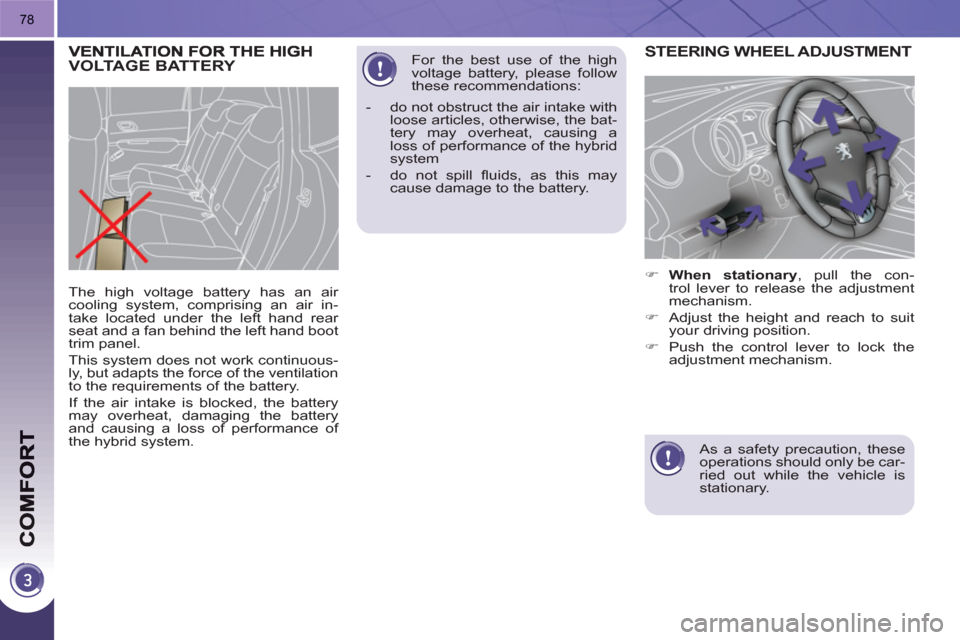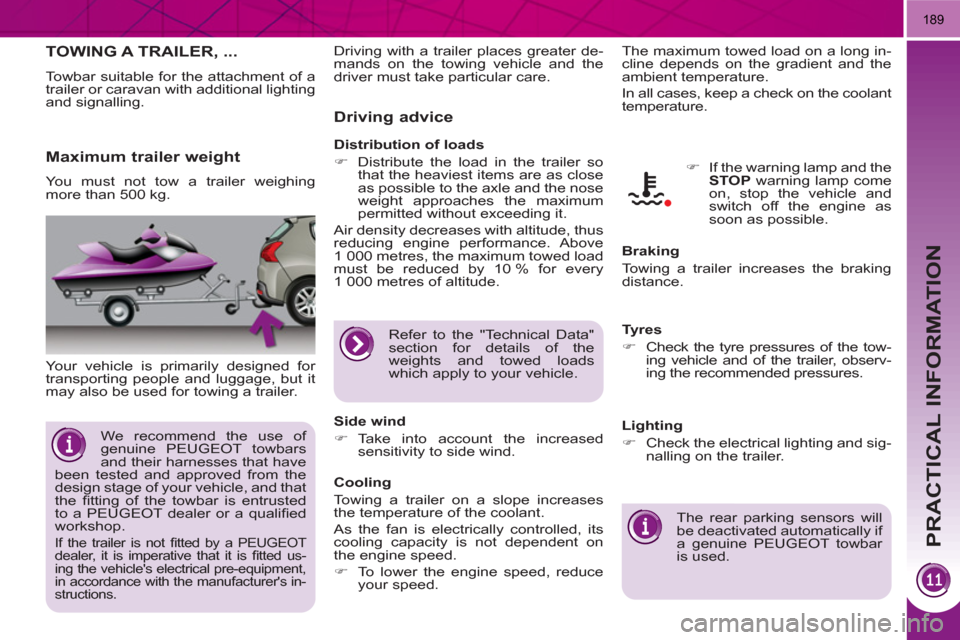2011 Peugeot 3008 Hybrid 4 cooling
[x] Cancel search: coolingPage 41 of 280

200 V HIGH VOLTAGE BATTERY
The Ni-MH (Nickel Metal Hydride) type
200 V high voltage battery is located
below the boot fl oor, close to the electric
motor. It is not recharged from a mains
supply.
Charging
This recovery allows the use of "free"
energy.
The battery charging time is very short
and is continuous.
A discharged battery (following ZEV
running or high load, for example) will
quickly return to a state of charge suf-
fi cient for full operation of the different
hybrid modes.
The recharge takes place automati-
cally when driving
(Auto mode to be
used in preference).
It can be faster:
- by avoiding sharp acceleration,
- by recovery on deceleration: it will
take around 5 minutes on a long de-
scent.
- it will take around 10 minutes if the
Diesel engine is left idling (forced
Diesel engine operation).
The high voltage battery has an air
cooling system, comprising an air in-
take located under the left hand rear
seat and a fan behind the left hand boot
trim panel.
This system does not work continuous-
ly, but adapts the force of the ventilation
to the requirements of the battery.
If the air intake is blocked, the battery
may overheat, damaging the battery
and causing a loss of performance of
the hybrid system. VENTILATION FOR THE HIGH VOLTAGE BATTERY
For the best use of the high
voltage battery, please follow
these recommendations:
-
do not obstruct the air intake with
loose articles, otherwise, the bat-
tery may overheat, causing a loss of
performance of the hybrid system
- do not spill fl uids, as this may
cause damage to the battery.
The battery is charged when the vehicle
decelerates, the electric motor then becom-
ing a generator and converts kinetic energy
into electrical energy (except if the speed of
the vehicle is above 70 mph (120 km/h)).
The battery is not recharged from a mains
supply.
If the high voltage battery does not re-
charge, contact a PEUGEOT dealer.
To preserve the service life of
the battery, the level of charge
never falls below 10 %, even
if a level of 0 bars is displayed
after ZEV running.
Page 53 of 280

51
Warning lamp
is on
Cause
Action/Observations
Engine
autodiagnosis
system
fi xed. The emission control system
has a fault. This lamp should switch off when the
engine is started.
If it does not switch off, contact a
PEUGEOT dealer urgently.
fl ashing. The engine management
system has a fault.
Risk of destruction of the catalytic convertor.
Have it checked by a PEUGEOT dealer.
Low fuel
level
fi xed with the needle
in the red zone. When it fi rst comes on there
remains approximately
6 litres
of fuel in the tank.
At this point, you begin to
use the fuel reserve.
Refuel as soon as possible to avoid
running out of fuel.
This warning lamp will come on every time
the ignition is switched on, until a suffi cient
addition of fuel is made.
Fuel tank capacity: approximately 56.5 litres
.
Never continue to drive until you run out of fuel, as this
could damage the emission control and injection systems.
Maximum
coolant
temperature
fi xed with the needle
in the red zone. The temperature of the
cooling system is too high. Stop as soon as it is safe to do so.
Wait until the engine has cooled down
before topping up the level, if necessary.
If the problem persists, contact a
PEUGEOT dealer.
Dynamic
stability
control
(ESP/ASR)
fl ashing. The ESP/ASR regulation is
active. The system optimises traction and
improves the directional stability of the
vehicle.
fi xed. Unless it has been deactivated
with the indicator lamp on the
button on, the ESP/ASR
system is faulty. Have it checked by a PEUGEOT dealer.
Anti-lock
Braking
System
(ABS)
fi xed. The anti-lock braking system
has a fault. The vehicle retains conventional
braking.
Drive carefully at reduced speed and
contact a PEUGEOT dealer without
delay.
Page 55 of 280

53
Coolant temperature indicator
With the engine running, when the nee-
dle is:
- in zone A
, the temperature is correct,
- in zone B
, the temperature is too
high; the max temperature warning
lamp 1
and the central STOP
warn-
ing lamp come on, accompanied by
an audible signal and a message in
the multifunction screen. After driving for a few minutes, the tem-
perature and pressure in the cooling
system increase.
To top up the level:
�)
wait for the engine to cool,
�)
unscrew the cap by two turns to allow
the pressure to drop,
�)
when the pressure has dropped,
remove the cap,
�)
top up the level to the "MAX" mark.
You must stop as soon as it is safe
to do so.
Wait a few minutes before switching off
the engine.
Consult a PEUGEOT dealer.
Page 72 of 280

70
Manual operation
If you wish, you can make a different
choice from that offered by the system
by changing a setting. The other func-
tions will still be controlled automati-
cally.
�)
Pressing the "AUTO"
button returns
the system to completely automatic
operation.
�)
Press this button to switch
off the air conditioning.
6. Air distribution adjustment
�)
Press one or more buttons
to direct the air fl ow to-
wards:
7. Air fl ow adjustment
�)
Turn this control to the left
to decrease the air fl ow or
to the right to increase the
air fl ow.
5. Air conditioning On/Off
- the windscreen and side windows
(demisting or defrosting),
- the windscreen, the side windows
and the vents,
- the windscreen, the side windows,
the vents and the footwells,
- the vents and the footwells,
- the vents,
- the footwells,
- the windscreen, the side windows
and the footwells.
The air fl ow indicator lamps, between
the two fans, come on progressively in
relation to the value requested. For maximum cooling or hea-
ting of the passenger compart-
ment, it is possible to exceed
the minimum value 14 or the maxi-
mum value 28.
�)
Turn control 2
or 3
to the left un-
til "LO"
(low) is displayed or to
the right until "HI"
(high) is dis-
played. Switching the system off could result in
some discomfort (humidity, condensa-
tion).
�)
Press this button again to return to
automatic operation of the air con-
ditioning. The indicator lamp in the
"A/C"
button comes on.
Page 80 of 280

78
The high voltage battery has an air
cooling system, comprising an air in-
take located under the left hand rear
seat and a fan behind the left hand boot
trim panel.
This system does not work continuous-
ly, but adapts the force of the ventilation
to the requirements of the battery.
If the air intake is blocked, the battery
may overheat, damaging the battery
and causing a loss of performance of
the hybrid system.
STEERING WHEEL ADJUSTMENT
�)
When stationary
, pull the con-
trol lever to release the adjustment
mechanism.
�)
Adjust the height and reach to suit
your driving position.
�)
Push the control lever to lock the
adjustment mechanism.
As a safety precaution, these
operations should only be car-
ried out while the vehicle is
stationary.
VOLTAGE BATTERY
For the best use of the high
voltage battery, please follow
these recommendations:
- do not obstruct the air intake with
loose articles, otherwise, the bat-
tery may overheat, causing a
loss of performance of the hybrid
system
- do not spill fl uids, as this may
cause damage to the battery.
Page 162 of 280

CHECKS
160
CHECKING LEVELS
Brake fluid level
On vehicles which are fi tted with a par-
ticle emission fi lter, the fan may oper-
ate after the vehicle has been switched
off, even if the engine is cold.
In addition, as the cooling system is
pressurised, wait at least one hour after
switching off the engine before carrying
out any work.
To avoid any risk of scalding, unscrew
the cap by two turns to allow the pres-
sure to drop. When the pressure has
dropped, remove the cap and top up
the level.
Oil level
The reading will only be correct
if the vehicle is on level ground
and the engine has been off for
more than 15 minutes.
The check is carried out either when the
ignition is switched on using the oil level
indicator on the instrument panel, or us-
ing the dipstick. The brake fl uid level should be
close to the "MAX" mark. If it is
not, check the brake pad wear.
Changing the fl uid
Refer to the Warranty and Maintenance
Record for details of the interval for this
operation.
Power steering fluid level
The power steering fl uid level
should be close to the "MAX"
mark. Unscrew the cap, with the
engine cold, to check the level.
Screenwash and headlamp
wash fluid
In the case of vehicles fi tted
with headlamp washers, the
minimum level of this fl uid is
indicated by an audible signal
and a message on the multi-
function screen.
Top up the level when you stop the ve-
hicle.
Engine oil change
Refer to the Warranty and Maintenance
Record for details of the interval for this
operation.
In order to maintain the reliability of the
engine and emission control system,
the use of additives in the engine oil is
prohibited.
Oil specifi cation
The oil must correspond to your engine
and conform to the manufacturer's rec-
ommendations.
Fluid specifi cation
The brake fl uid must conform to the
manufacturer's recommendations and
fulfi l the DOT4 standards.
Changing the coolant
The coolant does not have to be
changed.
Fluid specifi cation
For optimum cleaning and to avoid
freezing, this fl uid must not be topped
up with or replaced with plain water.
Coolant level
The coolant level should be
close to the "MAX" mark but
should never exceed it.
When the engine is warm, the tempera-
ture of the coolant is regulated by the
fan. This can operate with the ignition off.
Fluid specifi cation
The coolant must conform to the manu-
facturer's recommendations.
When working under the bon-
net, take care, as certain areas
of the engine may be extreme-
ly hot (risk of burns).
Before doing anything under
the bonnet, switch off the igni-
tion ( Ready
lamp off) to avoid
any risk of injury resulting from auto-
matic operation of the motor.
Check all of these levels regularly and
top them up if necessary, unless other-
wise indicated.
If a level drops signifi cantly, have the
corresponding system checked by a
PEUGEOT dealer.
Page 183 of 280

PRACTICAL INFORMATION
181
Fuse
N°
Rating
(A)
Functions
F12
30
Windscreen wipers slow/fast speed.
F13
40
Built-in systems interface supply
(ignition positive).
F14
30
Heater radiator water pump.
F15
10
Right-hand main beam headlamp.
F16
10
Left-hand main beam headlamp.
F17
15
Left-hand dipped headlamp.
F18
15
Right-hand dipped headlamp.
F19
15
Turbo pressure regulation electrovalve (Diesel).
F20
10
Engine coolant level detector (Diesel).
F21
5
Cooling fan control.
Page 191 of 280

PRACTICAL INFORMATION
189
TOWING A TRAILER, ...
Towbar suitable for the attachment of a
trailer or caravan with additional lighting
and signalling.
Your vehicle is primarily designed for
transporting people and luggage, but it
may also be used for towing a trailer.
Driving advice
The maximum towed load on a long in-
cline depends on the gradient and the
ambient temperature.
In all cases, keep a check on the coolant
temperature.
Cooling
Towing a trailer on a slope increases
the temperature of the coolant.
As the fan is electrically controlled, its
cooling capacity is not dependent on
the engine speed.
�)
To lower the engine speed, reduce
your speed.
Side wind
�)
Take into account the increased
sensitivity to side wind.
Tyres
�)
Check the tyre pressures of the tow-
ing vehicle and of the trailer, observ-
ing the recommended pressures.
Braking
Towing a trailer increases the braking
distance.
The rear parking sensors will
be deactivated automatically if
a genuine PEUGEOT towbar
is used.
�)
If the warning lamp and the
STOP
warning lamp come
on, stop the vehicle and
switch off the engine as
soon as possible.
Maximum trailer weight
You must not tow a trailer weighing
more than 500 kg.
Distribution of loads
�)
Distribute the load in the trailer so
that the heaviest items are as close
as possible to the axle and the nose
weight approaches the maximum
permitted without exceeding it.
Air density decreases with altitude, thus
reducing engine performance. Above
1 000 metres, the maximum towed load
must be reduced by 10 % for every
1 000 metres of altitude. Driving with a trailer places greater de-
mands on the towing vehicle and the
driver must take particular care.
We recommend the use of
genuine PEUGEOT towbars
and their harnesses that have
been tested and approved from the
design stage of your vehicle, and that
the fi tting of the towbar is entrusted
to a PEUGEOT dealer or a qualifi ed
workshop.
If the trailer is not fi tted by a PEUGEOT
dealer, it is imperative that it is fi tted us-
ing the vehicle's electrical pre-equipment,
in accordance with the manufacturer's in-
structions.
Lighting
�)
Check the electrical lighting and sig-
nalling on the trailer.
Refer to the "Technical Data"
section for details of the
weights and towed loads
which apply to your vehicle.